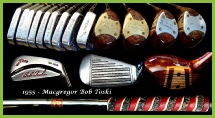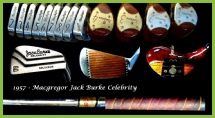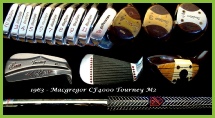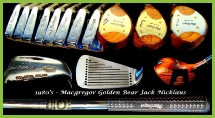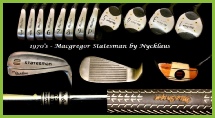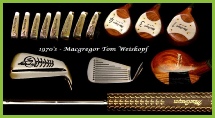
MacGregor Golf Company's origins date to the end of the 19th century and a company called Crawford, MacGregor and Canby, which manufactured wooden shoe lasts in Dayton, Ohio. The firm, which had been founded in 1822 as the Dayton Last Company, was co-owned by the Crawford brothers, John MacGregor, and Edward Canby. On a trip to Europe, Canby was introduced to the sport of golf, which had originated there and was especially popular in Scotland. Sensing a business opportunity if it became popular in the United States, he put his company's woodworking expertise to use and began manufacturing golf clubs with persimmon wood heads and hickory shafts.
Because much of the firm's output would initially be shipped to Great Britain, the brand was given the Scottish-sounding name "J. MacGregor," after Canby's partner. At a time when most club heads were carved by hand, the company took advantage of the lathe copying process with which it made shoe lasts, where a replica of a metal original was mechanically carved in wood, and within a few years the firm was producing 100,000 clubs per year. Over time, Canby became sole owner of the company.
In the 1920’s MacGregor was one of the first to offer steel-shafted clubs, and 1927 saw the first "Harmonized" club set, which included both wood and steel shafts. In the 1930’s, the company's name was officially changed to MacGregor Golf Co., and the "J." was dropped. That decade saw a number of innovations under the leadership of Toney Penna, who worked with such legendary players as Ben Hogan and Byron Nelson to create new club designs. Successes of the era included the "Neutralizer," a wooden dowel of spring hickory that was inserted in the shaft where it joined the head of the club, and a grip made of rubber and cord--previous ones had been made of leather. This "All-Weather" grip was soon adopted by most of the game's top players. MacGregor later created a soft rubber grip called the "Tri-Tac," which went on to be even more popular. Another innovation of the period, the "Four-Way Roll," improved the performance of wooden clubs by softening the edges of the club face, yielding a better result from off-center shots.
By the 1940’s MacGregor had become the sport's dominant club maker, with more than half of the players in Professional Golf Association (PGA) events using its clubs. Many top players of the era also signed on to the company's Advisory Staff. By now the firm had come under the control of Charles H. Rickey, who was serving as president. Tragically, in May 1945 he was killed in an automobile accident, after which his place was taken by Henry P. Cowen.
The late 1940’s saw MacGregor find success with the Tommy Armour line, which outsold all other professional clubs on the market. In 1949 the company introduced its first matching set of four "woods" (for long shots) and nine "irons" (for shorter shots). The so-called MT line was sold in a special display box which housed the 13 clubs as a single unit. Included with the irons was a sand wedge, the first time this type of club had been sold as part of a set. The MT line was enthusiastically accepted by golfers, and was credited with changing the way clubs were marketed from that point forward.
Despite a drop in the number of golf courses immediately following World War II (when some were converted to housing developments), the post-war years saw the public at large embrace golf as never before. By 1952 MacGregor's sales had increased eightfold from a decade earlier.
In the 1950’s MacGregor became one of the first golf firms to offer sponsorship to African-American professionals, at a time when the PGA had a "Caucasians only" clause in its constitution (which was not removed until 1961). Company president Bob Rickey was a nephew of the Brooklyn Dodgers' Branch Rickey, who had broken baseball's color barrier in 1947 by hiring Jackie Robinson. During the decade MacGregor also introduced the popular "Eye-O-Matic" woods, which featured a red and white fiber insert on the club face that helped visually frame its "sweet spot."
In 1967 the Rickey family sold MacGregor to Brunswick Corporation. The sporting goods firm held onto the company until 1979, when it was sold to retailer Wickes Corporation of San Diego, whose chairman, E.L. McNeely, was reportedly an avid golfer. In 1982, with Wickes strapped for cash, Jack Nicklaus and a MacGregor executive led a group that bought controlling interest in the company for $17 million. Nicklaus was one of the game's legends, and had endorsed MacGregor for nearly 20 years.
Once in charge of the company, Nicklaus poured himself into improving it. The firm had been in a slump since the 1960’s, both creatively and financially, and he involved himself in all aspects of the operation, helping bring MacGregor back into the black for the first time in 26 years.
In 1984 the company sold a 75 percent stake in a Japanese subsidiary it had launched in 1979 to whisky distiller Suntory, and by 1986 its annual sales stood at a reported $39 million. That year, when Nicklaus used a new MacGregor putter to win golf's prestigious Masters tournament, the company took orders for 5,000 of the clubs before noon the next business day.
In late 1986, Nicklaus and his partners sold 80 percent of MacGregor to Amer-Yhtymae OY, a Finnish company with holdings in consumer products, sporting goods, and tobacco. The price was a reported $30 million. MacGregor was now operating subsidiaries in Ireland, Britain, and Hong Kong, along with the Suntory-owned Japanese affiliate. Three years after acquiring the company, Amer Sport bought major American sporting goods firm Wilson for $200 million. MacGregor's Finnish parent now began looking to boost sales by remaking the firm in the more broad-based Wilson mold, and introduced less-expensive lines of clubs in pursuit of mass sales.
In November 1991 David M. Gibbons was named president and chief operating officer of MacGregor, replacing Robert Forbush who had held the job for just over a year. It was hinted that the firm would be merged into Wilson, but the plan was not carried out. MacGregor, now headquartered in Albany, Georgia, would remain there, with its corporate offices moved to that location from North Palm Beach, Florida.
In January 1992 Jack Nicklaus sold his remaining 20 percent stake in MacGregor to Amer Sport. He was reportedly frustrated with the direction the company had been taking, and announced plans to form a club manufacturer of his own through his Golden Bear International firm.
The year 1992 also saw MacGregor introduce the new T920 club, a "wood" made of titanium metal that was reportedly the first golf club designed with the help of a computer. Featuring an oversized head and a graphite shaft, a single club was priced at $500. The company also licensed the right to make golf pull carts and golf gloves to unrelated firm MacGregor Sports and Fitness, Inc. during the year.
The mid-1990’s saw MacGregor's financial picture deteriorate. Amer put out word that it would consider any offers to buy, while also again looking at the possibility of combining its operations with Wilson or even shutting the company down. In October 1996 it was announced that MacGregor would be sold to Masters International Ltd. of the United Kingdom and a consortium of investors for $19.6 million. The deal was finalized early the next year, after which William Marsh, formerly of the Breco Group of Companies, was named president and CEO.
In 1997, to celebrate its 100th anniversary, MacGregor brought out limited edition Centennial reproductions of some of its most celebrated club designs, consulting with retired company craftsmen to get the details right. New models were introduced under the Excentury name, including a titanium wood that was available with four different shafts, priced at between $772 and $947. The company also offered a trade-in deal in which golfers could get a discount on new MacGregor clubs if they brought in an old set, which the company would donate to youth organizations.
At the same time that it was announcing these promotions, MacGregor's new owners were formulating aggressive plans to revitalize the brand, which included a $10-15 million ad campaign, almost ten times what had been spent annually in recent years. In addition to clubs, the company was also marketing golf bags, balls, Gore-Tex outerwear, and accessories.
In August 1998, however, MacGregor was again sold, this time for a reported $42 million. The buyer was The Parkside Group, a newly-formed investment firm headed by Barry Schneider, who took the position of MacGregor's chairman. Schneider had previously run floor covering distributor MSA Industries, which he had sold to DuPont in 1997. After the sale William Marsh continued in the roles of president and CEO of the company, which now employed 200 and had estimated annual sales of $50 million.
In March 1999 MacGregor's first television ads since the mid-'90’s were run on The Golf Channel, complemented by print ads in several leading golf magazines. They were aimed at weekend golfers, and used light humor to tout the new line of Tourney clubs. Since the sale to Parkside, the company's product line had been almost completely revamped to emphasize classic, understated good looks and feel. Offerings ranged from sets of irons for under $1,000 to the one-of-a-kind Tourney Forged Personals, unique to each player, which were priced at $5,000. The company's low-end lines were simultaneously phased out in a bid to help re-position the brand as a premium product.
The fall of 1999 saw MacGregor switch ad agencies, the eighth such change in the previous 15 years. New television ads debuted in early 2000, and featured more humour, a rock music soundtrack, and an emphasis on the hand craftsmanship of the firm's clubs.
In July 2000 the company was once again put up for sale, but this time there were no takers. During that year and into 2001, MacGregor's advertising spending was curtailed, and in April 2001 a new president, John McNulty, was named. He had previously served as vice president of marketing at Brunswick.
After spending just over $1 million on advertising in 2001, which saw the worsening U.S. economy hit makers of luxury goods hard, the firm decided to boost its ad spending to $10 million in 2002. In conjunction with this move, owner and now CEO Barry Schneider published an open letter in several sports publications that addressed the firm's problems and laid out his plans for the future. The company was now working on grass-roots efforts such as in-store marketing, sponsoring college golf teams, holding 1,200 demonstration days nationwide, and boosting its presence on the PGA tour and with golf pros at clubs. 2002 also saw the firm name a new president, Dana Shertz, who had previously worked for industry leader Callaway Golf.
In the fall of 2003, MacGregor bought back control of MacGregor Golf Japan from Suntory. The profitable Japanese unit had successfully marketed its own MAC TEC brand of clubs since 1992, which the parent company now planned to sell worldwide. The lower-priced line was manufactured in China, and would be modified to meet U.S. golf rules before its introduction there in early 2005. The fall also saw the acquisition of Bobby Grace Putters, whose products would henceforth be made in MacGregor's Albany, Georgia plant.
After more than 100 years, MacGregor Golf Company was seeking to build on the legacy of its storied past to create a profitable future. With the commitment of owner and CEO Barry Schneider to turning the company around, hopes were high that its position of industry leadership could be restored.
Read more: http://www.answers.com/topic/macgregor-golf-company#ixzz1tGLa1yfH


